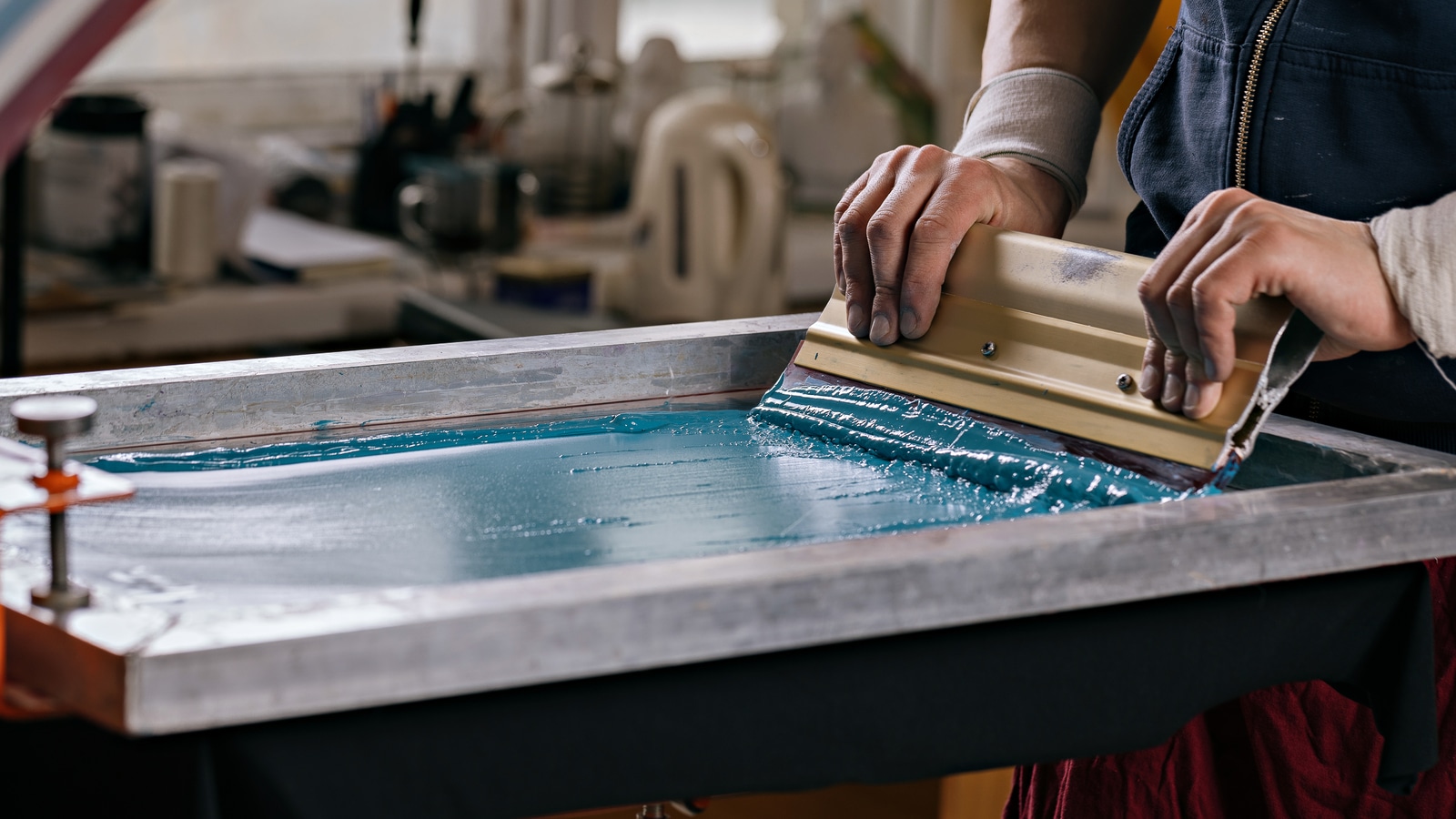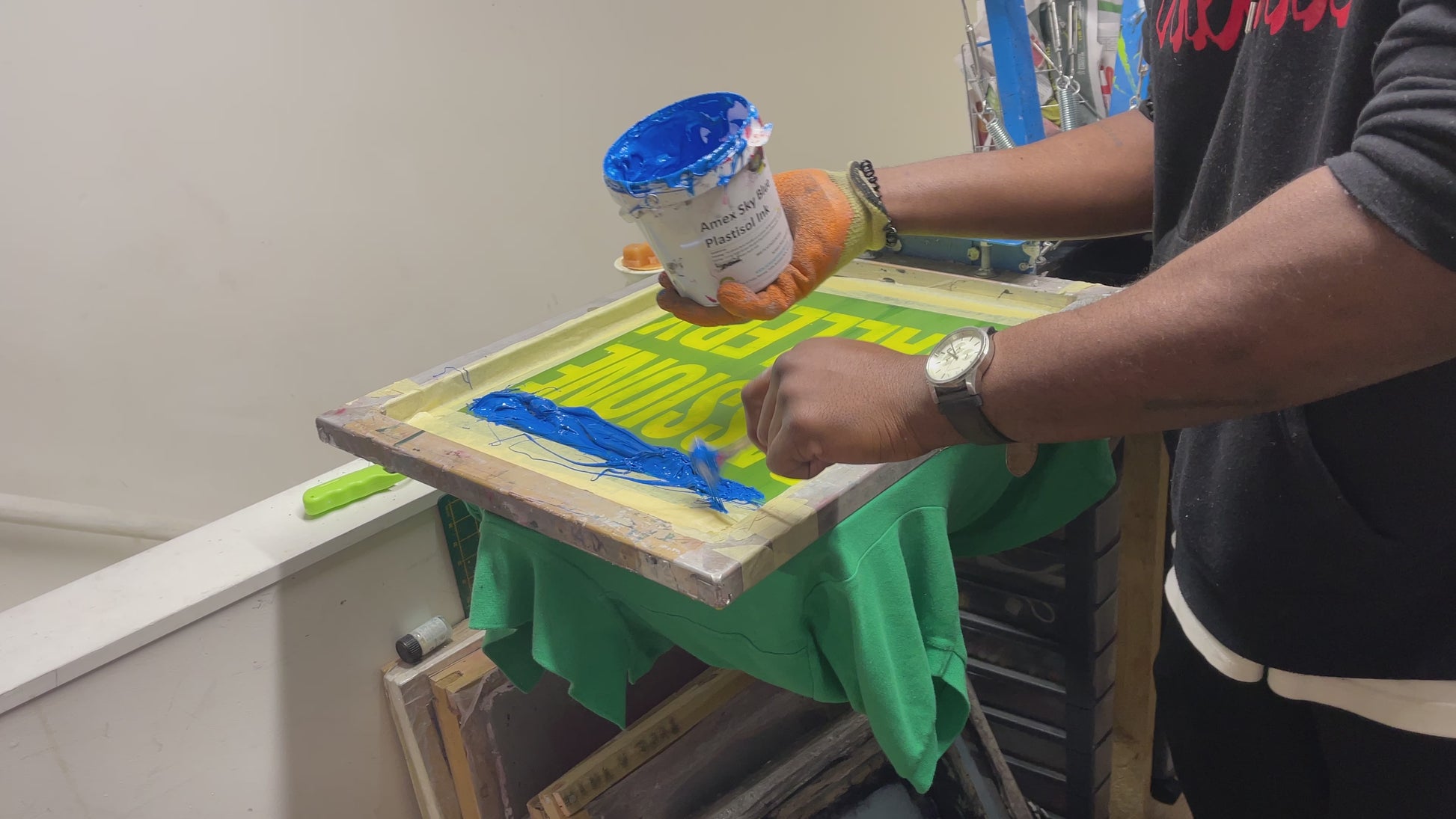Fast Turnaround Custom Screen Printing for Events
Fast Turnaround Custom Screen Printing for Events
Blog Article
Grasping Silk Screen Printing: Advice for Creating Stunning Designs
If you're looking to master silk display printing, you'll require even more than just interest. By the end, you'll be ready to produce stunning designs that reflect your unique style.
Recognizing the Essentials of Silk Screen Printing
Silk screen printing, often called display printing, is a versatile technique for moving styles onto numerous materials. You'll discover it's excellent for printing on fabrics, paper, plastic, and a lot more. The process entails developing a pattern, or display, that allows ink to go through only in specific areas, producing clean and vibrant styles.
To obtain started, you'll need to prepare your artwork, guaranteeing it remains in an appropriate style. screen printing kit. You'll coat your display with a light-sensitive emulsion and expose it to light as soon as you've got your design ready. This step creates a pattern of your layout on the screen
After rinsing the unexposed solution, you're readied to publish. Straighten your display over your product, use ink, and make use of a squeegee to press the ink through the display. It's everything about technique and patience, so don't hesitate to experiment and fine-tune your strategy as you go.
Crucial Tools and Materials You'll Require
To begin with silk screen printing, you'll require a couple of fundamental supplies like screens, squeegees, and ink. You can discover innovative devices that improves your printing quality and performance when you're comfy. Let's discuss what you'll need to guarantee your jobs achieve success from the start.
Basic Silk Screen Products
Beginning on a silk screen printing task requires a few important tools and products to guarantee your success. You'll need a silk display structure, which holds the mesh that moves your style. A squeegee is essential for pushing ink through the screen onto your substrate.
Advanced Printing Devices
When you prepare to take your silk screen printing to the next degree, investing in sophisticated printing equipment can make a considerable distinction. A top notch screen printing machine is important; try to find a multi-color press that allows for accurate enrollment and quicker production. You'll additionally intend to update to a more reliable direct exposure system to ensure your designs are sharp and lively.
Take into consideration spending in a reputable heat resource, like a conveyor clothes dryer, for even healing of inks. Do not ignore specialized inks; water-based and discharge inks offer outstanding outcomes on numerous fabrics. A good set of mops and solution scoop coater will certainly improve your procedure, providing your layouts that specialist side.
Preparing Your Artwork for Printing
Preparing your artwork for silk display printing is vital to achieving lively, professional outcomes. Beginning by validating your design is in the right format-- vector documents like.AI or.EPS job best.
When your documents is ready, produce a different layer for each and every shade in your layout. This'll make it easier throughout the printing procedure. Do not forget to include registration marks to line up colors appropriately.
Additionally, take into consideration the mesh count of your display; finer details may require a greater mesh matter. Finally, save your art work with a resolution of at the very least 300 DPI to ensure crisp prints. By complying with these actions, you'll set yourself up for a successful printing experience and bring your layouts to life wonderfully.
The Display Printing Process: Step-by-Step
Since you've prepared your art work, it's time to concentrate on the display printing process itself. You'll start by preparing your display, ensuring it's prepared for the ink application. From there, you'll check out numerous printing methods to accomplish the ideal results for your project.
Preparing Your Display
Getting your screen all set is a critical step in the silk display printing process. Initially, clean the screen extensively to eliminate any kind of residue, oil, or dust. Make use of a degreaser and rinse it well to ensure a smooth surface area for your emulsion. Next off, apply a light coat of emulsion evenly throughout the display using an inside story coater. See to it to do this in a dimly lit location to avoid early direct exposure. Enable the solution to completely dry entirely prior to revealing it to your layout. As soon as dry, position your transparency on the screen and utilize a light to subject the style. After exposure, rinse the unexposed emulsion, and you'll have your display gotten ready for printing.
Printing Methods Discussed
When your display is prepared, you can dive right into the amazing process of printing. Initially, place your display on your substrate-- whether it's material, paper, or an additional material. Secure it to prevent any kind of movement. Next off, put your ink onto one side of the screen and utilize a squeegee to pull the ink throughout the design. Apply even push to assure the ink permeates with the mesh. Lift the display meticulously to disclose your print. If you're layering colors, allow each layer dry prior to using the next. Tidy your display without delay to stop ink from drying out and blocking the mesh. With practice, you'll master the subtleties of pressure and timing, which will help you accomplish crisp, vivid styles.
Tips for Getting Vibrant Colors
While achieving dynamic shades in silk display printing might seem difficult, you can conveniently boost your designs with a couple of essential strategies. Select top notch inks particularly made for silk screen printing; they give far better coloring and insurance coverage. Mixing inks appropriately can likewise boost vibrancy-- trying out proportions to find the ideal mix that pops.

Finally, don't forget healing your prints correctly. Appropriate heat establishing warranties the colors bond with the fabric, maintaining their vibrancy over time. By implementing these techniques, you'll produce stunning, captivating layouts that really shine.
Repairing Common Printing Concerns
Despite vivid shades in your styles, silk screen printing can sometimes provide difficulties. One typical issue is ink bleeding, which typically happens when you utilize way too much ink or don't allow the previous layer dry totally. To avoid this, make use of a squeegee with just the appropriate stress and ensure each layer is dry before adding much more.
If your design isn't lining up correctly, confirm your registration marks and make changes to your screens. Tidy your displays completely prior to beginning your print run.
Last but not least, if the ink isn't adhering well to the textile, take into consideration the fabric type and the healing procedure. See to it you're utilizing the best ink which you're healing it at the suitable temperature level. Fixing these common issues will certainly assist you achieve stunning results.
Explore Impacts and strategies
Try out different techniques and impacts can raise your silk display printing tasks to brand-new elevations. Don't be worried to press borders! Try layering colors for depth; overlapping tones creates distinct blends that stand out. You can additionally have fun with appearances-- utilizing different squeegee techniques or integrating materials like brushes or sponges adds measurement to your prints.
Think about utilizing specialized inks, such as metal or glow-in-the-dark, to provide your styles an unanticipated twist. You might even check out stenciling, where you can cut elaborate styles for magnificent effects.
Do not ignore substrate variants! Printing on textiles, wood, or paper can yield various outcomes that boost your job's feeling.
Ultimately, keep a journal straight from the source of your experiments. Recording your successes and failings will assist your future productions and help you fine-tune your design. Welcome the procedure, and appreciate the journey of discovering what works best for you!
Regularly Asked Questions
How Do I Clean and Maintain My Screen Printing Devices?
To clean up and maintain your display printing devices, frequently scrub displays with an ideal cleaner, wash squeegees after use, and shop every little thing in a dry, dust-free atmosphere. Maintaining things clean assurances much better prints and longer-lasting devices.

Can I Print on Products Other Than Material?
Yes, you can publish on products aside from textile! Think about utilizing paper, wood, or plastic. Just make certain your displays and inks are compatible with those surfaces for the very best outcomes. Experiment and have enjoyable!
What Is the Finest Method to Store Displays and Inks?
To keep screens and inks efficiently, keep screens upright in a cool, dry location, and cover them to avoid dirt. Shop inks in impermeable containers, away from straight sunlight, to preserve their quality and uniformity.
How Do I Select the Right Mesh Count for My Task?
Selecting the best mesh matter relies on your design's information and ink kind. For fine information, go higher, like 200 mesh (screen printing kit). For strong designs, a reduced count, around 110, functions ideal. Experiment to find your perfect suit.
What Are the Ecological Influences of Silk Display Printing?
Silk screen printing can have environmental impacts, like chemical waste and water use. You can decrease these by utilizing environmentally see this website friendly inks, recycling materials, and properly disposing of chemicals to lower your task's eco-friendly impact.
Silk display printing, commonly called display printing, is a versatile method for transferring designs onto numerous products. Straighten your screen over your material, use ink, and make use of a squeegee to press the ink through the display.To obtain begun with silk screen printing, you'll require a few standard supplies like screens, squeegees, and ink.When you're prepared to take your silk display printing to the next level, spending in advanced printing devices can make a considerable distinction.Getting your screen prepared is a crucial action in the silk display printing process.
Report this page